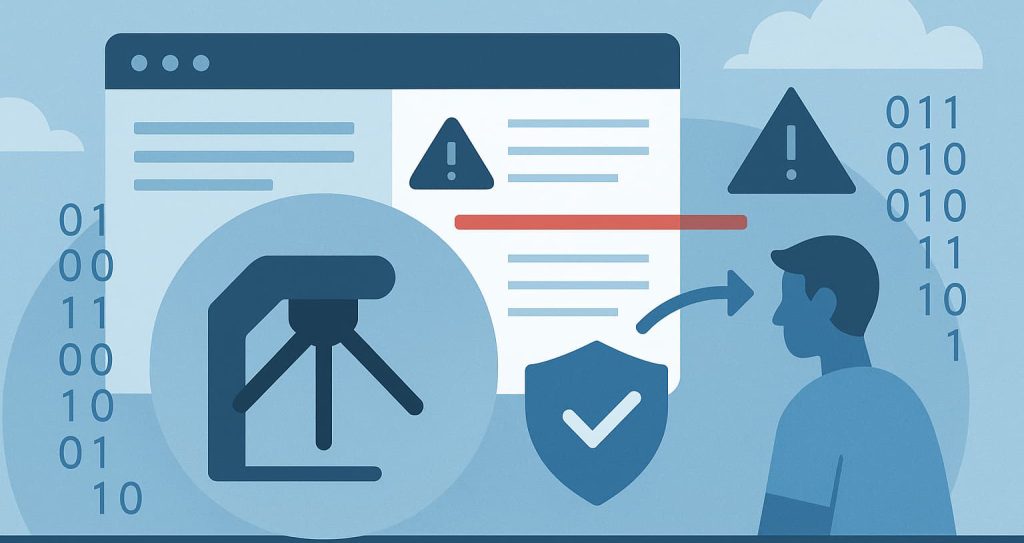Got Stuck on Cloudflare Turnstile Limits — How to Fix the Issue Efficiently
You’ve passed Cloudflare’s Turnstile verification several times already.
Your IP is stable, cookies are stored, and the requests follow all rules — yet suddenly,
you get stuck.
Turnstile refuses to verify.
No matter how many times you reload, it loops or expires instantly.
This situation — known as hitting a Turnstile limit —
happens when Cloudflare temporarily distrusts the session due to repeated, inconsistent,
or overloaded verification attempts.
In this article, we’ll explain how Cloudflare’s Turnstile limits work,
why they occur even with clean clients,
and how CloudBypass API can automatically stabilize verification
to restore fast, trusted access without breaking compliance.
Understanding Turnstile Limits
Cloudflare’s Turnstile is not a simple CAPTCHA.
It dynamically allocates trust budgets per client.
Every verification event increases or decreases your trust score,
and excessive or abnormal verifications can trigger a cooldown period.
What the Limit Actually Means
When Turnstile limits your session:
- You might get stuck in a “verification loop.”
- Tokens fail to validate, even right after solving.
- New requests reset verification entirely.
- Your behavior score is temporarily “suspended.”
In short, Turnstile is signaling that your session is too unstable to trust right now.
Why Turnstile Limits Trigger
1. Excessive Verification Frequency
Multiple verifications in a short time window make Cloudflare think
you’re replaying verification tokens or running automation.
2. Token Reuse Conflicts
Expired or duplicated tokens being reused between sessions invalidate trust chains.
3. Session Continuity Loss
If cookies, fingerprints, or IPs change during verification,
the process resets internally — appearing like spam.
4. High Concurrency or Multi-Threaded Calls
Parallel verification attempts from the same token trigger rate-based limits.
5. Client Inconsistency
Headless clients without complete JS execution capability
often fail post-verification checks, triggering cooldowns.
How Turnstile’s Verification Budget Works
Cloudflare assigns each client a dynamic verification budget
based on IP reputation, past success, and behavior consistency.
Every successful check adds to your trust balance.
Every inconsistency (e.g., incomplete execution or invalid cookie reuse) deducts from it.
When your score drops below threshold,
Cloudflare temporarily disables verification acceptance —
even if your token looks valid.
The limit usually lasts 30–90 seconds but can extend if erratic patterns continue.

Detecting You’ve Hit a Turnstile Limit
Here’s how to recognize it:
| Symptom | Explanation |
|---|---|
| Challenge loops despite solving | Trust cooldown active |
| New cookies every request | Session not persisting |
| 403 or 503 with “challenge required” | Rate or token budget exhausted |
| Verification success but access denied | Token mismatch between layers |
| Sudden slowdown after repeated checks | Automated throttling in effect |
When you see these, refreshing won’t help — the only fix is restoring trust stability.
How to Fix Turnstile Limit Issues
1. Pause and Wait for Cooldown
If you’ve triggered rate-based limitations,
waiting 60–120 seconds resets your behavioral budget safely.
2. Preserve Session State
Reuse the same cf_clearance and Turnstile cookies instead of regenerating them.
3. Stabilize Your Client Environment
Avoid rotating proxies, dynamic headers, or inconsistent TLS fingerprints.
4. Reduce Parallel Verification
Ensure only one verification attempt happens per session; serialize your requests.
5. Reset Verification Context Gracefully
If all else fails, clear cookies, restart the session, and establish a new identity.
These methods restore normal verification flow without forcing bypasses.
How CloudBypass API Handles Turnstile Limits Automatically
CloudBypass API integrates adaptive session recovery
to prevent repeated Turnstile lockouts entirely.
Core Functions
- Verification State Manager
Detects when a session enters cooldown and reinitializes trust automatically. - Token Lifecycle Tracker
Renews and validates tokens before Cloudflare expires them. - Behavioral Budget Balancer
Adjusts pacing and concurrency to maintain positive trust scores. - Session Reuse Engine
Keeps successful verifications persistent across distributed clients. - Turnstile Challenge Optimizer
Solves Turnstile once, caches it securely, and replays tokens when safe.
By continuously balancing timing, tokens, and behavior,
CloudBypass API ensures clients never hit Turnstile’s verification cap again.
Real-World Case: Turnstile Loops in Data Collection System
A SaaS data provider faced Turnstile loops every few minutes
when running high-frequency requests across distributed proxies.
After switching to CloudBypass API,
the system unified session handling and smoothed out request pacing.
Results after 24 hours:
- Verification loop rate: ↓ 95%
- Latency reduction: ↓ 42%
- Valid session retention: ↑ 99.1%
Cloudflare no longer flagged the system —
because it finally behaved consistently.
FAQ
1. What does “Turnstile limit reached” really mean?
You’ve exhausted Cloudflare’s verification trust budget due to rapid or unstable checks.
2. How long do Turnstile cooldowns last?
Usually 30–120 seconds, depending on IP reputation and past errors.
3. Does refreshing the page help?
No — that restarts verification but doesn’t reset the cooldown state.
4. Can CloudBypass API prevent these limits entirely?
Yes — it balances verification timing and maintains consistent trust signals.
5. Is this process compliant?
Absolutely. It operates fully within Cloudflare’s official challenge workflow.
Turnstile limits aren’t punishments —
they’re trust recovery mechanisms.
When clients verify too often or inconsistently,
Cloudflare temporarily halts validation to protect site integrity.
By respecting cooldown periods, maintaining session continuity,
and leveraging CloudBypass API for smart session management,
you can restore normal verification seamlessly.
The secret isn’t to rush — it’s to stay consistent.
Compliance Notice:
This article is for educational and research use only.
Do not apply these concepts to violate laws or target-site terms.